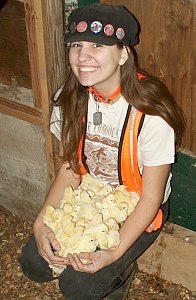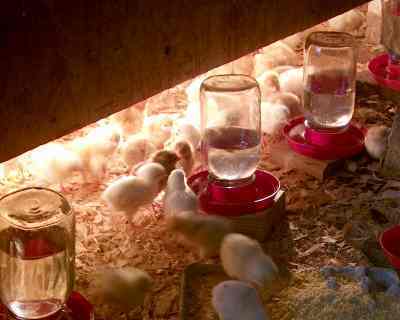
 Buy Now From
Buy Now From
Amazon.com
Book Lines
Chickens
Gardening
Back to the Land
Egyptian Archaeology
Role-Playing Games
Science Fiction
Boys' Adventures
Buy from Amazon.com
Buy from bn.com
News and Blog
Free Poultry Info
About Us

Gardening Without Work
More Information

Success With Baby Chicks
More Information

Fresh-Air Poultry Houses
More Information
Success With Baby Chicks
A Complete Guide to Hatchery Selection, Mail-Order Chicks, Day-Old Chick Care, Brooding, Brooder Plans, Feeding, and Housing
by Robert Plamondon
Norton Creek Press, March, 2003. ISBN 0972177000. 155 pages. Suggested Retail price, $15.95.

|
Your Baby Chicks are Helpless —
|
I spent years researching and testing these techniques on my free-range farm in Oregon. I read over a hundred books on poultrykeeping at Oregon State University's Valley Library, and surveyed a hundred years of poultry journals and magazines. It seems to have worked! Not only do my own chicks do well, but the book has been getting rave reviews since it came out. Not just from beginners, but from experienced poultrykeepers as well. Some highlights include an easy-to-build insulated brooder that will keep your chicks warmer while cutting your electric bill by two-thirds, how to brood chicks confidently in mid-winter, and exactly how you will go about feeding baby chicks.
Many of the techniques in this book were commonplace in our grandparents' generation, but were gradually forgotten after the switch to factory farming. My survey of a hundred years of poultrykeeping has restored much that had been lost.
You will avoid disaster and ensure a pleasant, successful experience when you buy this book today. For best results, read it before you get your baby chicks!
I devote entire chapters to subjects
that are normally dismissed in a paragraph or two, such as litter or waterers.
Overhead infrared heat-lamp brooding has a chapter to itself.
I cover these details because, with baby chicks, details are important. The issue isn't that ignorance
makes you less efficient, but that the baby chicks suffer. Read my book and this will never happen to you again.
My book is a real bargain. A good hen will lay at least $50 worth of eggs, even if you only value them
at supermarket prices. If my $15.95 books saves only one pullet chick, it repays itself three times over!
And when you use my techniques, you will do far better than this, time after time, year after year.
By now, you may be ready to skip the rest of the sales pitch and order now.
Like many people, I used to have a good baby-chick experience one time and a bad baby-chick experience the next.
There didn't seem to be any pattern to it. It was very frustrating, and it made me shy away from raising as many
chicks as I wanted. I had gone into free-range egg production almost by accident, and
I was never going to get anywhere unless brooding chicks went
from a dreaded chore to a high point of the year.
Baby chicks are such a joy when things go well, but never knowing whether your baby chicks are going to live or die
casts a pall of uncertainty and gloom over any poultry
operation. No one can enjoy poultrykeeping if their flocks suffer from high mortality.
And I don't even want to think about the effect it has on kids, who go into a poultry project brimming with optimism.
How can this be avoided?
I had the good luck to meet a retired lady who had raised 30,000 chicks a year for many years, and insisted that
raising chicks can
be done with almost perfect success on any scale. She claimed she lost 1% of the chicks during the first week (from shipping-related
stress), and the rest all survived to maturity. Bold claims, but she wasn't the only one to report such results!
You will benefit from my research. I have the good fortune to live near Oregon State University, which has
hundreds of poultry books and magazines in its library, dating back to before 1900. I flipped through all of them,
read most of them, and learned all kinds of things that used to be well known, but are now forgotten. Small farms and small flocks
used to be the norm, and agricultural research then as now focused on the mainstream. This means that the literature of 50-100 years ago
is filled with tested, proven, practical small-farm poultry techniques. Our grandparents' generation knew a lot about chickens.
First I read about their techniques, then I tried them. Then I read some more. A lot of concepts didn't sink in all at once, because
the information was scattered, and sometimes really crucial ideas were mentioned only in passing. But I kept at it.
My results with baby chicks kept getting better and better, and yours will, too. It wasn't that I had been
doing just one or two things wrong with my
initial batches of chicks. I had been doing dozens of things wrong! My initial reading of
"modern" poultry books hadn't prepared
me. And not only did I lack knowledge about techniques -- I didn't know any of the warning signs of
trouble. Things would get really bad before I knew that anything was wrong at all.
Here's an example: I bought 150 pullet chicks in May. When I moved them out of the brooder house on July 2, I had 154 live pullets! Negative mortality!
It's not really a miracle (hatcheries add extra chicks to cover losses in shipping), but "negative mortality" is pretty good by anybody's standard.
And when you buy my book and put my techniques to work, these results will become typical for you, too.
Not only do these techniques work better, they can save you money. In Chapters 7 and 8, I tell you how to
build an insulated electric brooder in two hours for about $20, which uses only about one-third the amount of electricity
as overhead heat lamps, and does a better job besides. It's an easy construction project that won't give you any trouble.
It and uses infrared heat lamps
or reflector floodlight bulbs. Many people have told me that
this information alone is worth the price of the book.
None of these techniques are very complicated.
I explain them fully in Success With Baby Chicks. My goal is to give you the
same kind of results and understanding in just one book that took me hundreds of books and more than five years to achieve.
My goal doesn't include getting you to buy lots of expensive equipment.
Being successful with baby chicks depends on your
understanding of the chicks and their needs. The actual equipment and housing requirements
are quite basic, and are much the same whether you are brooding
ten chicks or a thousand.
So buy the book right now! You can't benefit from its information until you read it.
I have a flock of 600 free-range laying hens, and my
wife Karen Black raises about 2,000 pastured broilers per year. Our enjoyment
of farming and the financial success of our farm depend on raising large
numbers of chicks successfully.
Chapter 1. Introduction Chapter 2. Brooding Quick-Start
I have been using the box now for 1 week, and I have lost only 1 chick. I
also am currently brooding them with only a 175 watt infared bulb (it has
been warm out here).
They seem to be very content and are already looking tasty.
Thanks for your help. The book is an excellent resource.
Ron Theusch You can order from any online bookseller. We like Amazon.com the best.
Buy Now From Amazon.com
You can also order from Amazon.co.uk or
Amazon.ca.
Your local bookstore will be happy to order this book for you. Success With Baby Chicks is distributed by Ingram Book Company.
My Early Baby Chick Troubles
How I Turned Things Around

How Well Does it Work?
Example: Build a 200-Chick Brooder in Two Hours for $20
You Can Have The Same Success
About My Farm
Table of Contents
Chapter 2. Brooding Quick-Start
Chapter 3. Breed and Hatchery Selection
Chapter 4. Chooosing Profitable Breeds
Chapter 5. Brooding Basics
Chapter 6. Overhead Heat Lamp Brooders
Chapter 7. Insulated Heat Lamp Brooders
Chapter 8. More About Insulated Heat Lamp Brooders
Chapter 9. Battery Brooders
Chapter 10. Other Brooders
Chapter 11. Feeding
Chapter 12. Waterers
Chapter 13. Litter
Chapter 14. Brooder Houses
Chapter 15. Health Problems and Predators
Chapter 16. Useful Tables
Chapter 17. Recommended Reading
Chapter 18. For More Information
Read the Sample Chapters!
Chapter 1. Introduction
A Testimonial
Since I got your book "Success with Baby Chicks" my mortality rate in
brooding has improved dramatically. We are raising 100 broiler chicks for
the first time in the brooder box you outlined in your book and I am just
amazed at its simplicity and effectiveness.
Alden, MN
Ordering Success With Baby Chicks
Order from Amazon.com
Order from BN.com
Order Success With Baby Chicks from Barnes & Noble.
Order From Your Favorite Bookstores
Bookstores and Resellers
Return to the Norton Creek Press Home
Page
Full of poultrykeeping and back-to-the-land info.